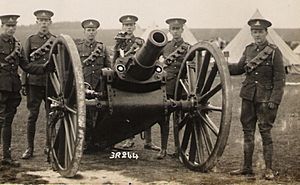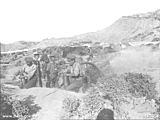BL 5-inch howitzer facts for kids
Quick facts for kids Ordnance BL 5-inch howitzer |
|
|---|---|

Territorial Force gunners with howitzer in camp pre-WWI
|
|
| Type | Field howitzer |
| Place of origin | United Kingdom |
| Service history | |
| In service | 1895 – 1919 |
| Used by | |
| Wars | Mahdist War Second Boer War First World War |
| Specifications | |
| Mass | 2,672 lb (1,212 kg) |
| Barrel length | 42 inches (1.07 m) bore (8.4 calibres) |
|
|
|
| Shell | 50 lb (22.7 kg) Common shell 50 lb (22.7 kg) Lyddite shell 40 lb (18.1 kg) Amatol shell |
| Calibre | 5-inch (127.0 mm) |
| Breech | 3-motion, interrupted screw |
| Recoil | 5.5 in (140 mm), Hydro-spring constant |
| Carriage | Wheeled, box trail |
| Elevation | -5° - 45° |
| Muzzle velocity | 788 ft/s (240 m/s) |
| Effective firing range | 4,800 yards (4,400 m) (50 lb shell); 6,500 yards (5,900 m) (40 lb shell) |
| Filling weight | 9 pounds 15 ounces (4.51 kg) (Lyddite) 5 pounds (2.27 kg) (Amatol) |
The Ordnance BL 5-inch howitzer was initially introduced to provide the Royal Field Artillery with continuing explosive shell capability following the decision to concentrate on shrapnel for field guns in the 1890s.
Contents
Combat service
Sudan Campaign
The weapon was used by the Royal Field Artillery and served successfully at the Battle of Omdurman in 1898. During that campaign they gained the distinction of being the first British guns to fire the new Lyddite shells in action.
Second Boer War
Major D Hall states that in the Second Boer War the Lyddite shells often failed to detonate; the gun was too heavy to be used as a field howitzer, and for siege use its range was too short and shell too light. However, it achieved some success in Natal when able to get close enough to bombard Boers in trenches.
World War I
By 1908 it was obsolete and replaced in British Regular Army brigades by the modern QF 4.5-inch howitzer.
Territorial Force brigades, however, continued to use the howitzer in World War I into 1916, including notably at the ANZAC and Suvla beachheads, Gallipoli, and in the East African campaign.
A lighter 40-pound (18.14 kg) shell with Amatol filling replaced the original 50-pound (22.68 kg) Lyddite shell early in World War I Together with an increase in cordite propellant from 11 oz 7 drams to 14 oz 5 drams, this increased the maximum range from 4,800 to 6,500 yards (5,900 m). Administrative error led to the new 40-pound shells being sent to Gallipoli without range tables or fuze keys for the new pattern fuzes, rendering them useless.
Gallery
-
In action on Gallipoli, 1915.
Ammunition
|
|
|
|
|
See also
Surviving examples
- At Karak Castle, Jordan
- National Military Museum, Bucharest, Romania









